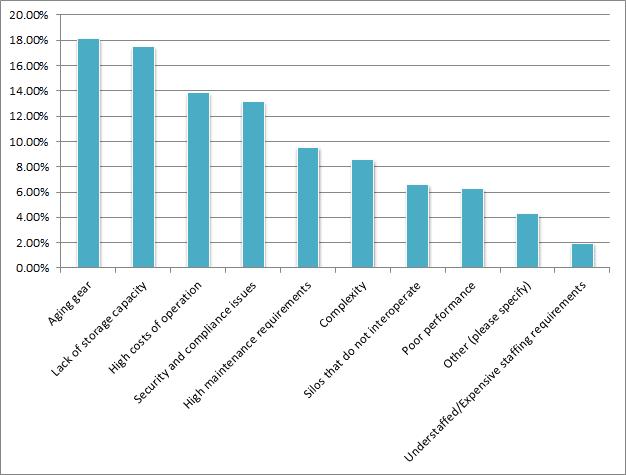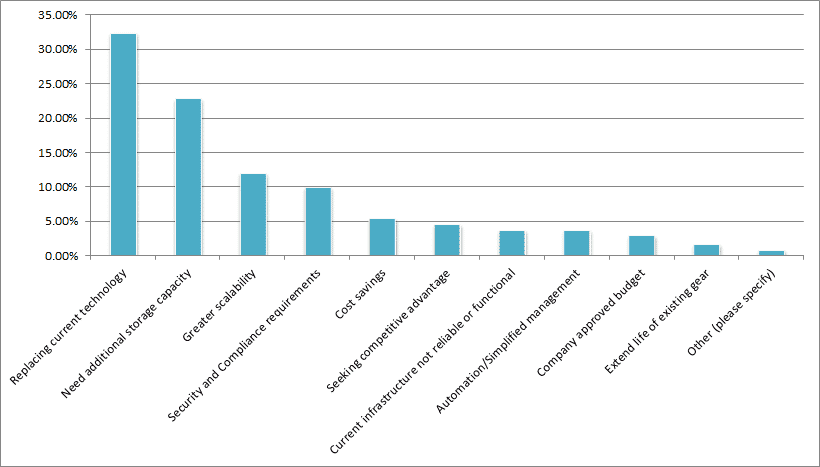Data storage has been around as long as computing, but based on the Enterprise Storage Forum survey, we have yet to solve all the problems. Entitled Data Storage Trends 2018, the survey reveals that storage professionals face no lack of serious concerns.
One of the interesting charts that jumped out at me is about the biggest challenge in operating current storage infrastructure. In essence, this is the “select your biggest pain” question. Let’s dive in.
See the highlights from our comprehensive survey of the data storage world: cloud storage, flash, HDD, disaster recovery and more in this .
Top Five Data Storage Challenges
Why are these ever-present data storage challenges? Why haven’t storage vendors researched technologies and nailed down solutions to solve them? This chart illustrates the leading pain points; we’ll look at the top five:
What is the biggest challenge involved with operating your current storage infrastructure?
1. Aging gear: Of course, no matter when you invest in new equipment, it starts aging immediately. And once deployed, storage, and the data stored on it tends to sit in the data center until it reaches some arbitrary vendor end-of-life (EOL) stage. With working storage the motto tends to be – “If it’s not broke, don’t fix it!”
Still, once something like storage is deployed, the capex is a sunk cost. Aging storage should probably be replaced long before full obsolescence comes along; significant attribute improvements are likely available on the market at any large storage’s “half-life.” These include better performance and agility, cheaper operating costs and upgrades, increased capacity and new features.
Here, I can’t blame storage vendors for lack of improved storage offerings. From flash engineered designs to software-defined agility, the storage landscape is full of opportunistic (and large ROI) “refresh” solutions. Proactive storage managers might think to replace their storage “ahead of time” as the scales tip in favor of new solutions, rather than sit back and wait for the traditional “five year” accounting-based storage refresh cycle.
2. Lack of Storage Capacity: Yes, data is still growing. In fact, data growth can be non-linear, which makes it hard to plan ahead. Unable to keep up with capacity demand, many organizations now rely on that elastic storage provider, cloud, hybrid cloud or even multi-cloud storage services – which can get pricey!
We may be doomed to suffer this pain point forever, but some newer storage technologies are being designed to scale-out “for a long time” with linear performance (e.g. Quobyte for primary, Cohesity for secondary). Scale-out big data solutions like HDFS (part of the Hadoop ecosystem) have been around for over a decade now, and yet most do not have large scale-out solutions (e.g. data lake) in production.
3. High Operational Costs: Why is storage still so difficult and onerous to manage properly? Direct staffing and admin costs are part of the equation, and much of that is linked to the leading problem of aging storage infrastructure (I didn’t say storage folks were aging, but…).
Older equipment also has relatively significant power and cooling needs, and larger data center space requirements. Heterogeneous storage operations can also impair effective troubleshooting and optimal tuning. Non-integrated backup, DR, and other data governance solutions only add to the complexity.
We do however, see new storage technologies that today can offer built-in policy-based automation, centralized management over distributed deployments and expert remote management “as a service” support offerings. And software-defined solutions leverage the latest commodity hardware which can be readily upgraded “underneath” as faster/better/cheaper silicon (chips and storage media) comes to market. Together these should help reduce data center operations costs, and more aggressively improve performance and capacity over time.
4. Security And Compliance: Security has always been an IT governance concern, but of all the pain points, this is probably the newest one to drag down storage infrastructure folks. Traditionally infrastructure was “below” security concerns like regulatory and compliance enforcement – that was handled at some higher level in the IT stack. But with distributed and cloud-hybrid storage architectures, storage itself must increasingly provide support for critical security services like encryption (both at rest and in-flight).
While adding some new facets for storage folk to manage, new storage solutions (including cloud storage) can offer valuable security features. These include geo-fencing, policy-based lifecycle retention, data-aware filtering, full user/workload audit trail reporting, and directly logged end-user services (e.g. file recovery).
5. High Maintenance Requirements: With a slightly different pain than just cost, many complained that maintenance requirements were still their biggest pain point. Maintenance can include patching, installing upgrades, repairing faults, securing infrastructure, and repairing faults with disks and power supplies.
This and several other pain points perhaps illustrate why hyperconverged solutions have become so popular, as HCI solutions “bake away” a large majority of component “stack” maintenance issues.
It’s also interesting to note what we don’t complain about anymore. I can remember that once upon a time major storage pain points included data loss and corruption, poor IO performance and storage capacity cost. Technologies like RAID, Flash, and in-storage processing power have laid many of these concerns to rest.
Pain Points and the Purchasing Decisions
How do these pain points affect purchasing plans? The Enterprise Storage Forum survey indicates that a good 80% have plans to buy new or more storage in the next two years (we suspect 100% will, but for whatever reason 20% haven’t yet made plans).
We can see that biggest motivators for buying new storage align reasonably well with the biggest pain points. Over 30% want to refresh their technologies (compare to “aging gear” above), while over 33% need to increase capacity or scalability (compare to lack of capacity above).
Yet the survey results for cost savings, automation and other purchasing rationale don’t fully line up with the pains above of high operations costs and maintenance burdens. We assume that most think that those pain points would be addressed in any informed refresh project.
What is the main reason your company is considering additional purchases of storage technology?
However, when we drill down into looking at the key qualities people want from new technologies, performance pops up to the top (see below). Performance wasn’t reported as “the” major pain point for very many folks, but clearly it’s a competitive storage feature that over 70% are expecting out of a new storage acquisition.
Cost is right up there as a key quality for over 70% as well, confirming our earlier assumptions, and we can also see simplification and automation ranking high.
What are the key qualities you’re looking for in the new technology? Select all that apply.
Solving the biggest pain points in storage today might involve newly emerging and still developing storage technologies – like hybrid cloud tiering, multiple levels of convergence, remote management services and ongoing silicon improvements (eg. Flash, NVMe).
These are all likely important drivers of the wide storage market. With so many complaining of “aging gear,” the outlook for new storage sales is looking up, and with so many “new” ways to assuage old and well-known pain points, we expect to see a lot of new storage deployments soon!








